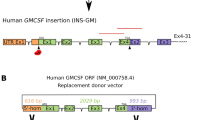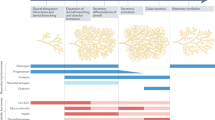Abstract
We have investigated, in mice, an in vivo method for producing low–lactose milk, based on the creation of transgenic animals carrying a hybrid gene in which the intestinal lactase–phlorizin hydrolase cDNA was placed under the control of the mammary–specific α–lactalbumin promoter. Transgenic females expressed lactase protein and activity during lactation at the apical side of mammary alveolar cells. Active lactase was also secreted into milk, anchored in the outer membrane of fat globules. Lactase synthesis in the mammary gland caused a significant decrease in milk lactose (50–85%) without obvious changes in fat and protein concentrations. Sucklings nourished with low–lactose milk developed normally. Hence, these data validate the use of transgenic animals expressing lactase in the mammary gland to produce low–lactose milk in vivo, and they demonstrate that the secretion of an intestinal digestive enzyme into milk can selectively modify its composition.
This is a preview of subscription content, access via your institution
Access options
Subscribe to this journal
Receive 12 print issues and online access
$209.00 per year
only $17.42 per issue
Buy this article
- Purchase on Springer Link
- Instant access to full article PDF
Prices may be subject to local taxes which are calculated during checkout




Similar content being viewed by others
References
Mercier, J.C. 1986. Genetic engineering applied to milk producing animals: some expectations, pp. 122–131 in Exploiting technologies in animal breeding–genetic development. Smith, C., King, J.W.B., and McKays, J.C. (eds.). Oxford University Press, Oxford, UK.
National Dairy Council. 1985. Nutritional implications of lactose and lactase activity. Dairy Counc. Dig. 56:25–30.
Mepham, T.B. 1987. The composition of milks, pp. 30–50 in Physiology of lactation. Mepham, T.B. (ed.). Open University Press, Milton Keynes, PA.
Sahi, T. 1994. Genetics and epidemiology of adult–type hypolactasia. Scand. J. Gastroenterol. 29:7–20.
Suarez, F.L., Savaiano, D.A., and Levitt, M.D. 1995. The treatment of lactose intolerance. Aliment. Pharmacol. Ther. 9:589–597.
Villako, K. and Maaroos, H. 1994. Clinical picture of hypolactasia and lactose intolerance. Scand. J. Gastroenterol. 29:36–54.
Savilahti, E., Launiala, K., and Kuitunen, P. 1983. Congenital lactase deficiency. Arch. Dis. Child. 58:246–252.
Cooper, B.T. 1986. Lactase deficiency and lactose malabsorption. Dig. Dis. 4:72–82.
Tamm, A. 1994. Management of lactose intolerance. Scand. J. Gastroenterol. 29:55–63.
Duluc, I. Boukamel, R., Mantei, N., Semenza, G., Raul, F., and Freund, J.N. 1991. Sequence of the precursor of intestinal lactase–phlorizin hydrolase from fetal rat. Gene 103:275–276.
Vilotte, J.L. and Soulier, S. 1992. Isolation and characterization of the mouse alpha–lactalbumin–encoding gene: interspecies comparison, tissue–and stage–specific expression. Gene 119:287–292.
Naim, H.Y., Sterchi, E.E., and Lentze, M.J. 1987. Biosynthesis and maturation of lactase–phlorizin hydrolase in the human small intestinal epithelial cells. Biochem. J. 241:427–434.
Büller, H.A., Montgomery, R.K., Sasak, W.V., and Grand, R.J. 1987. Biosynthesis, glycosylation and intracellular transport of intestinal lactase–phlorizin in rat. J. Biol. Chem. 262:17206–17211.
Naim, H.Y., Lacey, S.W., Sambrook, J.F., and Gething, M.J. 1991. Expression of a full–length cDNA coding for human intestinal lactase–phlorizin hydrolase reveals an uncleaved, enzymatically active, and transport–competent protein. J. Biol. Chem. 266:12313–12320.
Neele, A.M., Einerhand, A.W.C., Dekker, J., Büller, H.A., Freund, J.N., Verhave, M. et al. 1995. Verification of the rat lactase–phlorizin hydrolase site by site–directed mutagenesis. Gastroenterology 109:1234–1240.
Jost, B., Duluc, I., Richardson, M., Lathe, R., and Freund, J.N. 1997. Functional diversity and interactions between the repeat domains of rat intestinal lactase. Biochem. J. 327:95–103.
Brand, J.C. and Holt, S. 1991. Relative effectiveness of milks with reduced amounts of lactose in alleviating milk intolerance. Am. J. Clin. Nutr. 54:148–151.
Vesa, T.H., Korpela, R.A., and Sahi, T. 1996. Tolerance to small amounts of lactose in lactose maldigesters. Am. J. Clin. Nutr. 64:197–201.
Faerman, A., Barash, I., Puzis, R., Nathan, M., Hurwitz, D.R., and Shani, M. 1995. Dramatic heterogeneity of transgene expression in the lactating mammary gland of lactating mice: a model system to study the synthetic activity of mammary epithelial cells. J. Histochem. Cytochem. 4:461–470.
Molenaar, A.J., Davis, S.R., and Wilkins, R.J. 1992. Expression of α–lactalbumin, αS1–casein and lactotransferrin genes is heterogeneous in sheep and cattle mammary tissue. J. Histochem. Cytochem. 40:611–618.
Sasaki, M., Eigel, W.N., and Keenan, T.W. 1978. Lactose and major milk proteins are present in secretory vesicle–rich fractions from lactating mammary gland. Proc. Natl. Acad. Sci. USA 75:5020–5024.
Stinnakre, M.G., Vilotte, J.L., Soulier, S., and Mercier, J.C. 1994. Creation and phenotypic analysis of alpha–lactalbumin–deficient mice. Proc. Natl. Acad. Sci. USA 91:6544–6548.
DiTullio, P., Cheng, S.H., Marshall, J., Gregory, R.J., Ebert, K.M., Meade, H.M. et al. 1992. Production of cystic fibrosis transmembrane conductance regulator in the milk of transgenic mice. Bio/Technology 10:74–77.
Drews R., Paleyanda R.K., Lee T.K., Chang R.R., Rehemtulla A., Kaufman R.J. et al. 1995. Proteolytic maturation of protein C upon engineering the mouse mammary gland to express furin. Proc. Natl. Acad. Sci. USA 92:10462–10466.
Hauri, H.P., Sterchi, E.E., Bienz, D., Fransen, J.A., and Marxer, A. 1985. Expression and intracellular transport of microvillus membrane hydrolases in human intestinal epithelial cells. J. Cell Biol. 101:838–851.
Panzer, P., Preuss, U., Joberty, G., and Naim, H.Y. 1998. Protein domains implicated in intracellular transport and sorting of lactase–phlorizin hydrolase. J. Biol. Chem. 273:13861–13869.
Patton, S. and Keenan, T.W. 1975. The milk fat globule membrane. Biochim. Biophys. Acta. 415:273–309.
Drohan, W.N., Zhang, D.W., Paleyanda, R.K., Chang, R., Wroble, M., Velander, W. et al. 1994. Inefficient processing of human protein C in the mouse mammary gland. Transgenic Res. 3:355–364.
Rusconi, S., Severne, Y., Georgiev, O., Galli, I., and Wieland, S. 1990. A novel expression assay to study transcriptional activators. Gene 89:211–221.
Vilotte, J.L., Soulier, S., Paly, J., L'Huillier, P.J., Djiane, J., and Mercier, J.C. 1996. Introduction of a proximal STAT5 binding site into the murine α–lactalbumin promoter eliminates constitutive activity and leads to prolactin dependency in CHO and HC11 cells. Animal Genet. 27:A99.
Lathe, R., Vilotte, J.L., and Clark, A.J. 1987. Plasmid and bacteriophage vectors for excision of intact inserts. Gene 57:193–201.
Vilotte, J.L., Soulier, S., Stinnakre, M.G., Massoud, M., and Mercier, J.C. 1989. Efficient tissue–specific expression of bovine alpha–lactalbumin in transgenic mice. Eur. J. Biochem. 186:43–48.
Simons, J.P., McClenaghan, M., and Clark, A.J. 1987. Alteration of the quality of milk by expression of sheep beta–lactoglobulin in transgenic mice. Nature 328:530–532.
Hansen, S.A. 1975. Thin–layer chromatographic method for identification of oligosaccharides in starch hydrolyzates. J. Chromatogr. 105:388–390.
Bordier, C. 1981. Phase separation of integral membrane proteins in Triton X–114 solution. J. Biol. Chem. 256:1604–1607.
Schmitz, J., Preiser, H., Maestracci, D., Ghosh, B.K., Cerda, J.J., and Crane, R.K. 1973. Purification of the human intestinal brush border membrane. Biochim. Biophys. Acta. 323:98–112.
Nsi–Emvo, E., Launay, J.F., and Raul, F. 1986. Improved purification of rat intestinal lactase. Gen. Physiol. Biophys. 5:53–59.
Duluc, I., Jost, B., and Freund, J.N. 1993. Multiple levels of control of the stage– and region–specific expression of rat intestinal lactase. J. Cell Biol. 123:1577–1586.
Duluc, I., Freund, J–N., Leberquier, C., and Kedinger, M. 1994. Fetal endoderm primarily holds the temporal and positional information required for mammalian intestinal development. J. Cell Biol. 126:211–221.
Lucas, A., Gibbs, J.A.H., and Baum, J.D. 1978. Creamatocrit: a simple clinical technique for estimating fat concentration and energy value of human milk. Br. Med. J. 1:1018–1020.
Rodeau, J.–L. and Vilain, J.–P. 1987. Changes in membrane potential, membrane resistance, and intracellular H+, K+, Na+, and Cl− activities during the progesterone–induced maturation of urodele amphibian oocytes. Dev. Biol. 120:481–493.
Koldovsky, O., Asp, N.G., and Dahlqvist, A. 1969. A method for the separate assay of "neutral" and "acid" beta–galactosidase in homogenates of rat small intestinal mucosa. Anal. Biochem. 27:409–418.
Acknowledgements
We are most grateful to M.–G. Stinnakre and to S. Soulier (CIJ, INRA) for their technical help in the generation and identification of the transgenic founder mice.
Author information
Authors and Affiliations
Corresponding author
Rights and permissions
About this article
Cite this article
Jost, B., Vilotte, J., Duluc, I. et al. Production of low-lactose milk by ectopic expression of intestinal lactase in the mouse mammary gland. Nat Biotechnol 17, 160–164 (1999). https://doi.org/10.1038/6158
Received:
Accepted:
Issue Date:
DOI: https://doi.org/10.1038/6158
This article is cited by
-
Harnessing genomic information for livestock improvement
Nature Reviews Genetics (2019)
-
Strategies to enable the adoption of animal biotechnology to sustainably improve global food safety and security
Transgenic Research (2016)
-
Chemical constituents from Ficus tikoua
Chemistry of Natural Compounds (2012)
-
Expression of human growth hormone in the milk of transgenic rabbits with transgene mapped to the telomere region of chromosome 7q
Journal of Applied Genetics (2012)
-
Animal transgenesis: state of the art and applications
Journal of Applied Genetics (2007)



